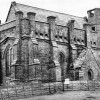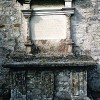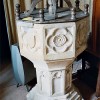Keeping Her Memory Alive
The village of Winfrith, with its thatched cottages, shop and old church, lies equidistant from Dorchester and Wareham in the farming county of Dorset. It hasn’t changed much since 1887 when Alice Maud Trent was born there, daughter of an agricultural labourer.
She must often have walked the four miles over the hills to Lulworth Cove, the beautiful circular inlet where the tides come in from the English Channel, and perhaps she dreamed of other lands, for she was to sail the world’s oceans.
Her father was William Trent, one of 14 children born to his father John Trent. The Trent family was a large group established primarily in the parish of Winfrith Newburgh, and especially in the Blacknoll area. William was baptised in 1852 at St. Christopher’s, Winfrith. He married Arabella Baker in 1874. She was also born in 1852 in the same place and baptised at Winfrith, and both were 22 years old when they married.
The couple had 11 children. William and Arabella both died in 1901 within a few weeks of each other from unrelated illnesses, having been born in the same year 48 years before.
Alice Maud was only 14, and had left home and the village. The most probable explanation for her whereabouts being that she was a ‘living in’ servant. The next sighting we have of her is in London where we know that during WWI she was a member of the Women’s Police Volunteers and was seconded to work with the wartime Ministry of Munitions.
She was, according to Steven Trent Galbraith, her grandson, “a very worldly woman” in the sense that at 36 she decided to go to the other side of the globe. During 1923 she worked as an asylum nurse in Australia, while visiting her sister Emma there.
She decided to return to England via the United States so as to call on her other sister, Sarah Kate now married to Henry Burden, in Brigham City in the far west state of Utah. And here a rather astonishing thing now takes place: she meets somehow or other, at the age of 37, with George Galbraith, 73 – and in May of 1924 they are married. George, who was Steven Galbraith’s grandfather, had an exciting life.
The first son born in the United States of Scottish immigrants, at 19 he was working on cattle drives from Texas to Wyoming. But when she said goodbye to Alice Maud in Australia, Emma could have had no idea that her sister would meet up with a former cowboy.
Robert Galbraith and his wife Helen had come across the Atlantic from Loch Lomond and the Trossachs, via Liverpool with four children. They settled in Illinois.
George was a perfect candidate for the Wild West. He was to have eight children by his wife Grace, and became foreman of a huge cattle ranch on the Utah-Wyoming border. He lost his wife in 1918 when he was 67, and later took his family to Utah where he made a good living from a fruit farm.
When Alice Maud married George in 1924, one of her children by law was older than she. They had a son, William Trent Galbraith, in 1925: he only lived for two days. Three years later Ernest, Steven’s father, was born when Alice Maud was 40.
The Great Depression now descended on the country. And in 1937, Alice Maud passed away: leaving a twice-married widower aged 86, and Ernest, aged 10. Two years later in 1939, George died leaving Ernest an orphan and the remaining half-brothers and sisters ranging in age from 47 to 61. One of the sisters raised Ernest to adulthood, and from the age of 16 he was going to sea, visiting ports all over the world – perhaps taking his cue from his adventurous mother and aunt.
Steven was given the middle name of Trent to keep alive the memory of the girl from Dorset. And he says today, after considerably digging into his family’s history: “The night before I married Lori, my wife, my Dad pulled me aside and gave me the ring that his father married Alice Trent with. Then, when my son Joshua was born, I named him Joshua Trent Galbraith….” Steven hopes and expects Joshua will similarly name his first son.
It was back in 1985 that Steven started on his genealogical journey, with very little to go on, one of the family having destroyed all the documents and photographs of Alice Maud that she could find. A few have survived.
We have only the briefest information about the youngest sister Alice Emma Trent, baptised March 10, 1895. She was only six years old when her parents died and it is likely she lived with the eldest child in the family, Rhoda Trent. She had married and was still living in Winfrith. All we know about Alice Emma is that she travelled to Australia where it is believed she married a man named Ernest Cummings and lived in New South Wales.
It is worth saying something about Alice Maud’s sister Sarah Kate. We know she was at home in 1901 when she would have been 16 years old. The next we know of her is that she is in the United States working as a maid in the household of Lord Bryce, the British Ambassador.
She decided to stay in the United States and travelled to Brigham City, on the shores of the Great Salt Lake and surrounded for hundreds of miles by mountains up to 10,000 feet – a vast contrast to the rolling wolds of native Dorset. Here she married Henry Burden. We think there is little doubt she knew him before travelling because he, like her, was from Winfrith.
In June 2002 Steven and Ernest came to Dorset: they met Trent family descendants still living in the area and others travelled to meet them.
Steve related how when a 12 year old boy his Mother had told him how difficult it had been for his father as a youngster and how other family members had “tried so hard to destroy the memory of Alice Maud Trent.” Steve says “ She and my Dad in a way to keep her memory alive, gave me Trent as a middle name and they asked me if I would like, it would be a nice thing if I did the same if I ever had a son.”
Those few days in Dorset the culmination of years of searching mean Steven has fulfilled a promise he made 36 years ago, when as a 12 year old boy he pledged he would find her and keep her memory alive.
More photographs of Alice Maud Trent and a photograph of Steven Trent Galbraith with his father Ernest taken during their 2002 visit to Dorset, can be found in the gallery section.
Ernest Galbraith passed away on the 28th June 2003.
Photos in the gallery



